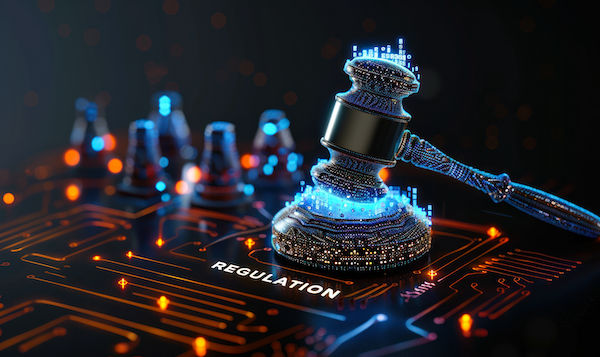ISO 42001: Your guide to the best AI management system standard

What if the key to unlocking the future of responsible AI lies in a single standard? As artificial intelligence (AI) reshapes industries at lightning speed, the question isn’t just how fast we can innovate—it’s how securely and ethically we can do it. Enter ISO 42001, the emerging standard for AI governance. Designed to tackle the complex web of ethical concerns, cybersecurity risks, and regulatory requirements, this framework offers a roadmap for organizations to ensure their AI systems are not only powerful but also transparent, compliant, and trustworthy.
Mastering AI governance: Navigating the future of technology

As artificial intelligence continues to evolve, the importance of AI governance cannot be overstated. AI governance involves establishing a comprehensive framework of policies, regulations, and guidelines that oversee the creation, deployment, and use of AI technology. This framework is crucial for mitigating risks associated with AI, such as bias, job displacement, and privacy concerns. Effective AI governance ensures that AI is not only innovative but also responsible, transparent, and aligned with human values and societal norms.
The role of AI governance in responsible AI development
AI governance plays a pivotal role in the responsible development of AI systems. It involves creating and enforcing policies that guide the ethical use of AI technologies. These policies help organizations navigate the complex landscape of AI, ensuring that their systems are developed and deployed in a manner that is ethical and compliant with regulatory standards. By aligning AI systems with human values and societal norms, AI governance fosters trust and accountability, making it easier for organizations to innovate responsibly.
Ensuring accountability, transparency, and fairness in AI
Accountability, transparency, and fairness are the cornerstones of effective AI governance. Accountability ensures that those responsible for developing and deploying AI frameworks are held accountable for their actions. This involves creating clear documentation and audit trails that explain how these frameworks make decisions. Transparency, on the other hand, involves making the decision-making processes of AI open and understandable to users. This helps build trust and allows for better oversight. Fairness ensures that AI systems do not perpetuate existing social inequalities and are designed to be unbiased and equitable. Together, these elements ensure that AI are not only effective but also ethical and trustworthy.
Mitigating risks such as bias and job displacement
One of the primary goals of AI governance is to mitigate the risks associated with AI, such as bias and job displacement. Bias in AI systems can occur at various stages, from data collection to algorithm design, leading to unfair or discriminatory outcomes. Effective AI governance involves identifying and addressing these biases to ensure the AI is fair and equitable. Additionally, AI governance helps mitigate the threat of job displacement by promoting the responsible deployment of AI technologies. This includes creating policies that support workforce transition and re-skilling, ensuring that the benefits of AI are shared broadly across society.
Growth of AI in cybersecurity

AI is the past, present, and future of cybersecurity in the modern world we live in today. It’s set to become a whopping $1.3 Trillion dollar market by 2032! Not only does it allow bad actors to become stealthier and faster, leveraging basic GPT AI systems to automate attacks, evade detection with adaptive techniques, and exploit vulnerabilities at unprecedented speed. On the other hand, it’s also enabling businesses to move faster and innovate more freely, allowing for rapid threat detection, predictive insights, and automation of complex processes. It can play a crucial role in managing and mitigating cyber risk, helping organizations strengthen their overall security posture. It’s role can be used for good and bad, much like the question, “Are you a good witch or a bad witch?”—it all depends on who’s wielding the power.
Key cybersecurity AI challenges and benefits of ISO 42001
As AI evolves, so too do the ethical, legal, and operational challenges it brings, from transparency issues to compliance with data privacy laws. Herein lies the importance of ISO 42001, a forthcoming standard aimed at establishing clear governance frameworks for AI, designed to help organizations ensure responsible, ethical, and legally compliant AI use. Addressing the complexities that come along with AI governance. ISO 42001 also addresses cyber risk as part of its governance framework, helping organizations manage and mitigate potential security threats.
Let’s get a lay of the land now, and address the main challenges with some real-world examples, and benefits of ISO 42001 for these challenges when it comes to AI governance:
Data privacy and security
AI relies on large datasets, often containing sensitive information. Managing cybersecurity risks is crucial for ensuring data is protected and compliant with privacy regulations like GDPR and California Consumer Privacy Act (CCPA), as well as aligned with ethical and legal standards. This makes it challenging to protect sensitive information while staying within regulatory boundaries.
Real-world, industry-specific example: Retail
A retail company utilizing AI for customer behavior analysis must prioritize the security and anonymization of this data. To prevent breaches and ensure adherence with local, state, federal, and global AI governance protection laws, companies should implement strategies such as encryption, multi-factor authentication (MFA), comprehensive employee training, and effective incident response plans.
Benefits of ISO 42001 for privacy and security
Stringent data handling standards are a fundamental aspect of ISO 42001, enabling businesses to safeguard sensitive information. By establishing clear privacy policies, secure storage methods, and strong access controls, organizations can significantly diminish the threat of a data breaches due to AI.
Transparency and accountability
Many AI models, particularly machine learning algorithms, operate as “black boxes,” making it hard to explain their decision-making processes. This lack of transparency can erode trust. So transparency and accountability are uber important to build trust and alignment with regulatory requirements.
Real-world, industry-specific example: Utilities
In the utilities industry, AI is often used to predict energy consumption patterns and optimize distribution. However, if an AI model makes an error—such as overestimating demand and causing an unnecessary increase in production costs or underestimating demand and leading to outages—it can be difficult to trace the cause due to the model’s complexity. This lack of transparency and accountability can make it challenging for utilities to explain or justify AI-driven decisions to regulators and customers, especially if these errors impact service reliability or costs.
Benefits of ISO 42001 for transparency and accountability
A framework for documenting key aspects of AI decision-making processes, to help clarify how AI systems arrive at their outcomes and who is responsible for those outcomes at each step. Thus providing accountability, transparency, and trust amongst stakeholders for AI processes.
Bias and fairness
Bias and fairness in AI governance are a core concern because there can be bias in AI systems that produce unfair or discriminatory results. This bias can be introduced at different stages of the AI process, including during data collection, algorithm design, human interpretation, and infrastructure. To ensure ethical AI use, we must reduce bias and promote fairness, making AI systems responsible, equitable, and trustworthy.
Real-world, industry-specific example: Banking
In the banking industry, if an AI system used for loan approvals cannot provide transparency on it’s decision making process, it’s challenging to prove that the model isn’t unfairly favoring or disadvantaging certain applicants based on factors like income level or zip code. This lack of transparency can lead to regulatory scrutiny and legal challenges, impacting the bank’s reputation and compliance standing.
Benefits of ISO 42001 for bias and fairness
ISO 42001 provides structured guidelines to proactively identify, monitor and mitigate biases in AI systems is essential for achieving fairness. This framework ensures a standard for data collection and model development, ensuring that training data is representative, diverse, and regularly audited, reducing the risk of embedding historical or systemic biases in AI models. Organization’s benefit from this because they are then able to analyze and explain AI outputs for fairness and adjust algorithms as needed.
Risk management
AI introduces specific risks that require continuous monitoring, such as cybersecurity risk, data poisoning, adversarial attacks, model inversion, and unauthorized access, which can lead to compromised data integrity, privacy breaches, and malicious manipulation of AI behavior. To assess and mitigate these risks, effective frameworks should be incorporated into the tools and processes that monitor AI to prevent reputational and operational harm.
Real-world, industry-specific example: Healthcare
In healthcare, adversarial attacks on AI diagnostic systems could subtly alter medical images, leading to misdiagnoses and incorrect treatment recommendations. Similarly, data poisoning in training datasets could bias the AI toward incorrect conclusions, jeopardizing patient safety and trust in AI-driven healthcare.
Benefits of ISO 42001 for risk management
With ISO 42001, organizations establish a structured approach to identifying and mitigating AI-specific risks, allowing them to proactively address potential issues and reduce the likelihood of harm from algorithmic bias and unintended outcomes.
Ethical and regulatory compliance
Ethical and regulatory compliance in AI governance is challenging because not only is AI innovation outpacing existing laws, but it often operates in ways that are difficult to audit or fully comprehend. Regulatory frameworks for AI also vary widely across regions, so ensuring transparency and accountability in AI operations is complex making it difficult t align with regulatory expectations consistently.
Real-world, industry-specific example: Telecommunications
In the telecommunications industry, AI is often used for customer service automation, such as chatbots and call routing, which can inadvertently result in biased treatment of customers based on demographics if the training data includes historical biases. For instance, certain accents or dialects might be misinterpreted or deprioritized, leading to unfair service outcomes. Additionally, strict data privacy regulations like the GDPR require careful handling of customer data, yet AI systems may inadvertently retain or misuse data if not properly governed, putting telecom companies at risk of regulatory penalties and eroding customer trust.
Benefits of ISO 42001 for ethical and regulatory compliance
The standard aligns AI practices with ethical principles and regulatory requirements, helping organizations fulfill legal obligations, uphold ethical standards, and adapt to changing regulations. This alignment not only bolsters their legal standing but also improves their public reputation, ultimately helping organizations avoid fines and reputational damage.
Future predictions in AI governance

As AI continues to unfold and explode into the world, transforming industries and reshaping our daily lives, we have a few predictions. The rapid advancements in artificial intelligence technology are paving the way for innovations we can only begin to imagine, from enhancing automation in various sectors to revolutionizing how we interact with our devices. As we delve deeper into the AI landscape, it’s essential to consider the potential impacts and opportunities that lie ahead in the world of cybersecurity.
- Increased global regulations in AI: AI-specific regulations across governments globally will be introduced, making ISO 42001 compliance even more critical for businesses.
- Advancements in explainable AI: Making it easier for companies to adhere to ISO 42001 by providing transparency in AI decision-making, enabling clearer accountability and compliance with governance standards.
- Integration of virtual Chief Information Security Officer (vCISO) for AI governance: Virtual Chief Information Security Officers (vCISOs) will play a crucial role in supporting businesses with cybersecurity programs that will support governance. They offer valuable cybersecurity expertise in compliance, risk management, and the implementation of frameworks such as ISO 42001. Managing cyber risk will become increasingly important, with vCISOs conducting comprehensive cyber risk assessments to help organizations strengthen their overall security posture.
- Growth in AI risk management tools: As AI software spending is projected to double to $64 million by 2025, the emergence of advanced tools for monitoring and mitigating AI risks will simplify the process for organizations to achieve ISO 42001 compliance.
Conclusion: The importance of AI governance and ISO 42001 for responsible AI use

ISO 42001 offers a comprehensive and robust framework for managing AI responsibly, with clear guidelines for transparency, compliance, and risk management. Proactively adopting AI governance frameworks like ISO 42001 will ensure compliance, accountability, and ethical AI practices. Ultimately, this framework will protect your business, acting as a shield from advanced and evolving threats that AI has introduced into our world, ensuring that your organization can continue innovating securely and freely.
How Cyber Defense Group’s virtual CISO team can help
Businesses seeking to build effective AI governance frameworks that promote growth, efficiency, and trust can rely on Cyber Defense Group as a trusted partner for their cybersecurity needs. We provide you guidance through the complexities of AI governance, ensuring a secure and successful integration. Our virtual CISO team members are experts in ISO 42001 and are ready to guide you through an effective AI framework that meets your business goals and objectives.
Ready to bring structure and security to your AI initiatives? Contact Cyber Defense Group today to discovery how our virtual CISO team can help you implement a cybersecurity program to effectively fortify your business and increase your security posture.
Frequently asked questions
What is ISO/IEC 42001?
ISO/IEC 42001 is a global standard that governs the ethical development and usage of artificial intelligence systems. It outlines a comprehensive framework for AI governance, emphasizing leadership, planning, support, and continual improvement.
Why is ISO/IEC 42001 important for AI governance?
ISO/IEC 42001 is essential for AI governance because it enables organizations to foster trust and uphold ethical standards in their AI applications. By offering guidelines for risk management and evaluating the societal impact of AI, it ensures responsible usage and enhances organizational reputation.
What are the key elements of ISO/IEC 42001?
The key elements of ISO/IEC 42001 are risk management, continuous learning and improvement, and ethical considerations, which collectively ensure the responsible management of AI systems throughout their lifecycle. These components align with global best practices and ethical standards.
How can organizations implement ISO/IEC 42001?
Organizations can effectively implement ISO/IEC 42001 by conducting a gap analysis, assembling a dedicated cybersecurity expert, like a virtual CISO, skilled in AI and compliance, and ensuring thorough documentation of all AI system development processes. This structured approach will facilitate compliance and enhance risk management.
What are the benefits of adopting ISO/IEC 42001?
The adoption of ISO/IEC 42001 significantly enhances risk management in AI, promotes innovation, and improves organizational reputation while ensuring compliance with emerging regulations. This standard fosters trust in AI products, providing a competitive advantage in the market.
